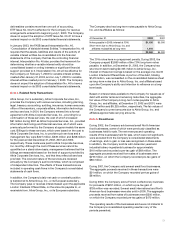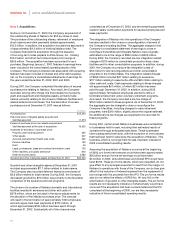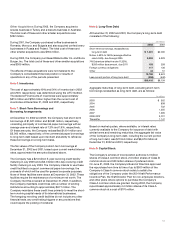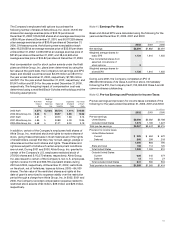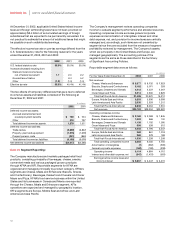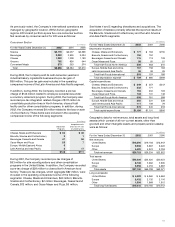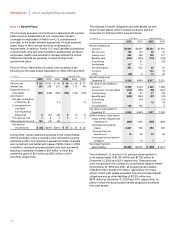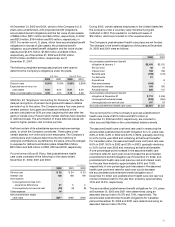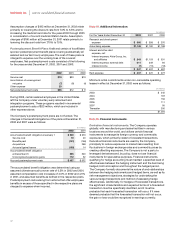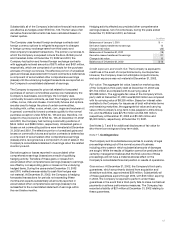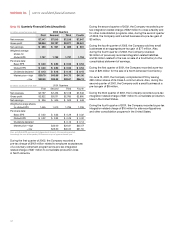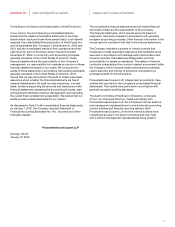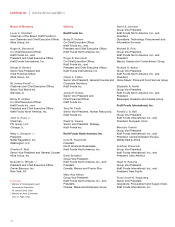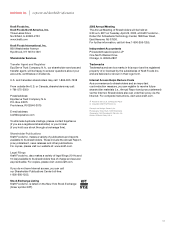Kraft 2002 Annual Report Download - page 64
Download and view the complete annual report
Please find page 64 of the 2002 Kraft annual report below. You can navigate through the pages in the report by either clicking on the pages listed below, or by using the keyword search tool below to find specific information within the annual report.
60
kraft foods inc. notes to consolidated financial statements
Assumption changes of $193 million at December 31, 2002 relate
primarily to lowering the discount rate from 7.0% to 6.5% and to
increasing the medical trend rate for the years 2003 through 2005
in consideration of current medical inflation trends. Assumption
changes of $180 million at December 31, 2001 relate primarily to
lowering the discount rate from 7.75% to 7.0%.
Postemployment Benefit Plans: Kraft and certain of its affiliates
sponsor postemployment benefit plans covering substantially all
salaried and certain hourly employees. The cost of these plans is
charged to expense over the working lives of the covered
employees. Net postemployment costs consisted of the following
for the years ended December 31, 2002, 2001 and 2000:
(in millions)
2002 2001 2000
Service cost $19 $20 $13
Amortization of unrecognized
net gains (7) (8) (4)
Other expense 23
Net postemployment costs $35 $12 $ 9
During 2002, certain salaried employees in the United States
left the Company under voluntary early retirement and
integration programs. These programs resulted in incremental
postemployment costs of $23 million, which are included in
other expense above.
The Company’s postemployment plans are not funded. The
changes in the benefit obligations of the plans at December 31,
2002 and 2001 were as follows:
(in millions)
2002 2001
Accumulated benefit obligation at January 1 $ 520 $ 373
Service cost 19 20
Benefits paid (141) (156)
Acquisitions 269
Actuarial (gains) losses (103) 14
Accumulated benefit obligation
at December 31 295 520
Unrecognized experience gains 112 52
Accrued postemployment costs $ 407 $ 572
The accumulated benefit obligation was determined using an
assumed ultimate annual turnover rate of 0.3% in 2002 and 2001,
assumed compensation cost increases of 4.0% in 2002 and 4.5%
in 2001, and assumed benefits as defined in the respective plans.
Postemployment costs arising from actions that offer employees
benefits in excess of those specified in the respective plans are
charged to expense when incurred.
Note 15. Additional Information:
(in millions)
For the Years Ended December 31, 2002 2001 2000
Research and development
expense $ 360 $ 358 $ 270
Advertising expense $1,145 $1,190 $1,198
Interest and other debt
expense, net:
Interest expense, Altria Group, Inc.
and affiliates $ 243 $1,103 $ 531
Interest expense, external debt 611 349 84
Interest income (7) (15) (18)
$ 847 $1,437 $ 597
Rent expense $ 437 $ 372 $ 277
Minimum rental commitments under non-cancelable operating
leases in effect at December 31, 2002 were as follows:
(in millions)
2003 $ 245
2004 197
2005 156
2006 111
2007 95
Thereafter 200
$1,004
Note 16. Financial Instruments:
Derivative financial instruments: The Company operates
globally, with manufacturing and sales facilities in various
locations around the world, and utilizes certain financial
instruments to manage its foreign currency and commodity
exposures, which primarily relate to forecasted transactions.
Derivative financial instruments are used by the Company,
principally to reduce exposures to market risks resulting from
fluctuations in foreign exchange rates and commodity prices by
creating offsetting exposures. The Company is not a party to
leveraged derivatives and, by policy, does not use financial
instruments for speculative purposes. Financial instruments
qualifying for hedge accounting must maintain a specified level of
effectiveness between the hedging instrument and the item being
hedged, both at inception and throughout the hedged period.
The Company formally documents the nature of and relationships
between the hedging instruments and hedged items, as well as its
risk-management objectives, strategies for undertaking the
various hedge transactions and method of assessing hedge
effectiveness. Additionally, for hedges of forecasted transactions,
the significant characteristics and expected terms of a forecasted
transaction must be specifically identified, and it must be
probable that each forecasted transaction will occur. If it were
deemed probable that the forecasted transaction will not occur,
the gain or loss would be recognized in earnings currently.



